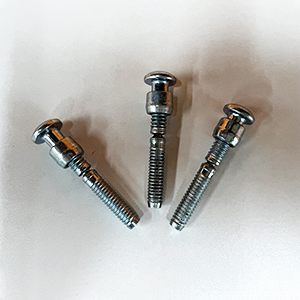Ring groove rivets refer to a special type of rivet. Ring groove rivets are divided into large diameter ring groove rivets, small diameter ring groove rivets, continuous groove ring groove rivets, and short tail rivets (bobtail). Ring groove rivets are made of high-quality carbon steel Made of rivets, the strength is high and the riveting is strong and reliable. Its biggest features are good vibration resistance, wide application and convenient construction.
Ring groove rivets are used to rivet two structural parts into one piece. They are composed of two parts: a rivet and a nail sleeve. The rivet is composed of a nail rod and a nail sleeve. When riveting, first insert the rivet into the nail hole of the connected piece. , then put the nail sleeve on the ring groove of the working section of the rivet from the other side of the connected piece, and then use a special tool - the muzzle of the pneumatic ring groove rivet gun to put it on the ring groove of the clamping section of the rivet, and push the gun Press the mouth against the end face of the nail sleeve, and then pull the trigger on the gun. The rivet gun will tighten the nail rod of the clamping section of the rivet until it breaks. At this time, the inner wall of the nail sleeve squeezes into the working section of the rivet, forming a New rivet heads are used to rivet and tighten the connected parts. Its characteristics are: easy operation, high efficiency, low noise, and good earthquake resistance, so it is used in various vehicles, ships, aviation, mechanical equipment, building structures and other fields.
What should you pay attention to during operation? Precautions for operating ring groove rivets:
(1) When riveting, the head of the riveting gun should be kept perpendicular to the surface of the workpiece, and sufficient pressure should be applied to make the nail sleeve close to the workpiece;
(2) When riveting blind-type ring-groove nails, the power of the power part and the rivet head must meet the specifications and shape requirements of the rivets;
(3) The action of inserting or driving the rivet into the hole must be light and steady;
(4) When starting to rivet, push the head of the draw gun to the bottom and hold the draw gun firmly;
(5) After riveting, if the nail head is not close to the component, it is never allowed to drive the nail head closer together;
(6) When riveting steel ring-groove nails, the pressure regulating valve of the pulling gun must be adjusted to the high-pressure position;
(7) When riveting upsetting-type ring-groove nails, pay attention to selecting appropriate riveting bricks, otherwise the nail sleeve cannot be properly held;
(8) Pay attention to prevent the nail rod from being bruised or damaging the workpiece due to the rebound of the gun when the nail rod is broken;
(9) After making the holes, you must use a sandwich thickness gauge to check the sandwich thickness of the riveted parts to select the appropriate rivet length.

Related News
- Types of wire drawing rivets and anti-rust methods
- What are the functions of rivets?
- How to use blind rivets
- What is a rivet nut?
- Structure introduction and maintenance of rivet gun
- Application of Lantern Rivet Nut
- Classification and application of rivet standoffs
- The working principle and selection rules of riveting gun
- The use of rivet nuts
- Comparison of drawing rivet connection and traditional craftsmanship
- Why can ring groove rivets be used on vibrating screens?
- Principles, materials and uses of large cap rivet nuts
- Reasons why burrs appear after blind rivets are drawn
- How to effectively prevent stainless steel rivets from oxidizing
- Do you know the characteristics of lantern rivets?
- Factors to consider when selecting rivets
- How to install the bolts of the rivet gun
- Introduction to the application and performance of wire drawing rivets
- How to prevent oxidation of rivets
- Characteristics of lantern rivets



